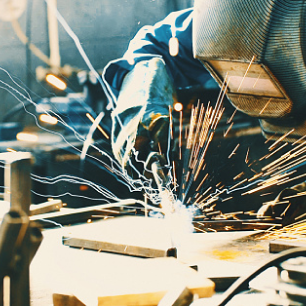Jump to:
The Role of the CWI or SCWI in Fracture Critical Applications
When identified in contract documents, the requirements for inspection and testing of fracture critical materials and welds may be significantly different from standard procedures and production welds typically encountered by the Certified Welding Inspector (CWI) or Senior Certified Welding Inspector (SCWI).
A fracture critical member (FCM) is defined within the American Association of State Highway and Transportation Officials (AASHTO)/AWS D1.5M/D1.5:2020, Bridge Welding Code, section 12. AASHTO/AWS Fracture Control Plan (FCP) for Nonredundant Members, sub-
section 12.2, Definitions, states, “12.2.2 Fracture Critical Member (FCM). AASHTO LRFD Bridge Design Specifications define an FCM as a steel primary member or portion thereof subject to tension whose failure would probably cause a portion of or the entire bridge to collapse.”
For many certified inspectors, bridge welding was not a part of their original career choice, and they prefer to work with standard structural fabrication and erection described in AWS D1.1/D1.1M:2020, Structural Welding Code — Steel, or other industry standards for piping, equipment, or tanks. However, recent initiatives by the U.S. Congress to improve the nation’s infrastructure have placed inspectors from different industries in positions where they need to become familiar with the codes and other standards relating to bridges.
This article is intended to identify and discuss the topics related to fracture critical materials and welds during the quality and inspection procedure development phase, as follows:
The source and rationale for fracture critical materials and welds
- How does the inspector know that a procedure, materials, and welds are fracture critical?
- What codes and standards are used to govern fracture critical?
- What is the FCP?
- What is the relationship between the inspector and the engineer of record?
Special testing requirements for welding procedure specifications (WPSs) used to produce fracture critical welds
- Are prequalified welding procedure specifications (PWPSs) allowed for fracture critical welds?
- What welding processes are allowed?
- What materials are allowed?
- What special considerations are there for filler metals or base metals?
- What is the reference for removal (location) of supplemental Charpy V-Notch (CVN) test specimens?
Personnel qualification and certification required for fracture critical applications
- What are the personnel requirements within the governing documents?
- Are specific CWI/SCWI endorsements required for fracture critical?
The inspector should note that the relevant section in D1.5M/D1.5 regarding the special requirements for FCM is section 12, AASHTO/AWS Fracture Control Plan (FCP) for Nonredundant Members. This approach to identifying fracture critical members and weldments focuses on the requirement for an FCP, which will be used whenever the engineer of record identifies structural members as fracture critical. Bridge structures that do not contain fracture critical members rely on the content of all sections of D1.5M/D1.5, except section 12.
In addition to AWS D1.5M/D1.5, standards such as AASHTO’s Manual for Bridge Evaluation (MBE), National Bridge Inspection Standards (NBIS), the Federal Highway Administration (FHWA) manuals, and AASHTO Bridge Design Specifications (LRFD) all have information the inspector will need when going into a bridge project where the engineer has identified a FCM. Furthermore, any company wishing to perform construction or fabrication of bridges with FCMs must be certified under the American Institute of Steel Construction (AISC) Quality Certification Program, Category III, Major Steel Bridges with Fracture Critical Rating.
Identifying the Presence of FCMs
Identifying the presence of FCMs must begin during the prebid phase to alert all bidders of the need to include requirements contained in section 12 of D1.5M/D1.5. This addition to the scope of the project has a significant impact on the value of fabrication contracts. Additionally, the presence of FCMs and fracture critical welds requires that the list of contractors be restricted to those with specific experience in fabricating steel with FCMs, as defined by the engineer.
The FCP referenced earlier contains the requirements of section 12 of AASHTO/AWS D1.5M/D1.5 and those additional requirements specified by the engineer of record. The FCP is a document clearly spelling out for both production and quality personnel the requirements that will apply to that specific project and that have been reviewed and approved by the engineer. Because different engineers of record may supplement Section 12 differently, it should be expected that some differences will occur between projects. The inspector must be familiar with the requirements of the FCP as it applies to the project at hand.
FCMs require mill orders of base metals to be manufactured of killed carbon steel and fine-grain base metals normalized, quenched, and tempered as specified with accompanying CVN results at the temperature specified by the engineer, all of which must be included in the contract documents. These requirements are typically specified for orders for structural shapes large enough to consume an entire heat (ladle) at a steel mill, finished and tested to the buyer’s specifications, and used to fill only that order. Finding small quantities or partial heats meeting these special requirements and documentation would be very difficult for purchasing and inspection, as noncritical structural shapes are rarely manufactured, tested, and accompanied by this level of documentation. Regardless of whether they’re from a mill order or a smaller quantity, all base metal surfaces and edges must be inspected for discontinuities upon arrival at the fabricator or construction site.
Welding Processes and Consumables
According to subsection 12.5, Welding Processes, the following processes listed in 12.5.1 may be used to construct or repair FCMs: shielded metal arc welding (SMAW), submerged arc welding (SAW), flux cored arc welding (FCAW), and gas metal arc welding (GMAW) with metal cored electrodes. Conversely, in 12.5.2, Prohibited Processes and Procedure Restrictions, electroslag welding (ESW) and electrogas welding (EGW) are prohibited for welding FCMs. When GMAW is used (except as allowed in 12.5.1), qualification tests, procedure control, and nondestructive examination (NDE) shall be as specified by the engineer. Subsection 12.5.3, Preferred Processes and Procedures, further stipulates that the engineer may designate specific processes or process controls for specific bridge welds. All special provisions shall be specified in the contract documents. Other restrictions, if any, on the use of welding processes or procedures shall be described in the contract documents.
Prequalified Welding Procedures are allowed to be used for welds in FCMs but only for SMAW using E7016, E7018, E7018-1, and E8018-X electrodes, including those with the C alloy and M classification as well as the R supplemental designator. All other groove weld WPSs using approved welding processes (SAW, FCAW, and GMAW) require testing — including CVN — to have been generated within a year of the start of production welding of FCMs.
Filler metals and fluxes used in FCMs, except for SMAW electrodes, are required to be tested and documented for diffusible hydrogen to meet optional designator H4, H8, or H16 (for ≤ 50 ksi – 345 MPa) or designator H4 or H8 (for ≥ 50 ksi – 345 MPa). Handling, storage, and drying of filler metals generally follow the manufacturer’s recommendations; however, these may be modified by the engineer.
According to 6.1.3.2, Heat or Lot Testing, all welding consumables shall be heat or lot tested by the manufacturer to determine conformance with the applicable AWS A5.XX specification. The engineer must also be given certified copies of the test results. The heat and lot information shall be as defined in the latest edition of AWS A5.01, Welding and Brazing Consumables — Procurement of Filler Metals and Fluxes. The consumables shall also be tested by welding as specified in the appropriate AWS filler metal specifications. All tests required by AWS A5.01, Schedule J, shall be performed and reported. Also specified by 6.1.3.2, materials of the same specification, classification, brand, product trade name, and manufacturer (but not necessarily the same heat or lot) to be combined during production welding shall be used for heat and lot testing.
Additional consumable requirements are given in 6.1.3.1, Consumable Manufacturer Quality Assurance Program, which states: “Welding consumables shall be produced under continuing quality assurance programs audited and approved by one or more of the following agencies: (1) American Bureau of Shipping (ABS), (2) Lloyd’s Register of Shipping, and (3) American Society of Mechanical Engineers (ASME).”
Examination and Quality
Quality functions are shared by the engineer and the contractor’s or fabricator’s inspector. The engineer is responsible for quality assurance (QA), and the inspector is responsible for quality control (QC). The engineer may contract for QA surveillance and audits; however, the final responsibility for the quality of the finished product rests with the contractor or fabricator. The FCP includes a designation for lead inspectors, who are required to have a minimum of three years of experience specifically in steel bridge construction or fabrication in addition to being a current or former AWS CWI, or an engineer or technician acceptable to the engineer of record (AWS D1.5M/D1.5, sections 8.1.3, Inspection Personnel Qualification, and 12.16.1.1, Inspectors). This lead inspector has the final determination for the acceptability of FCMs and welds associated with FCMs.
The lead inspector must ensure that any NDE technicians assigned to test FCMs are currently certified Level II or III in the appropriate method per the American Society for Nondestructive Testing (ASNT) Recommended Practice SNT-TC-1A. The engineer may accept alternative qualifications for NDE personnel that are deemed equivalent.
One of the many unique requirements contained within section 8 of AWS D1.5M/D1.5 is that radiographic examination of welds in FCMs must use hole-type penetrameter (IQI) to capture the quality-level hole size specified in the contract. Wire-type IQI is not allowed for this application. This, and many more such special requirements, is found throughout section 8 and explains the challenges to inspectors ensuring that all requirements are met every time FCMs are identified.
AWS D1.5M/D1.5 covers the welding requirements for welded bridges made from carbon and alloy construction steels and designed to AASHTO or American Railway Engineering and Maintenance-of-Way Association (AREMA) requirements.
Conclusion
Even with a high-level review of requirements outlined in section 12 of AASHTO/AWS D1.5M/D1.5, inspectors seeking to expand their work experience into infrastructure —
specifically bridge construction and fabrication — will be faced with a large volume of knowledge to master. The three-year experience requirement for a lead inspector can be met by working on bridge fabrication under the supervision of a lead inspector. Once the experience requirement is met and documented by the employer, the inspector can then consider a lead inspector role.
For current CWIs interested in bridge inspection, the authors recommend a code review course focusing on AASHTO/AWS D1.5M/D1.5 and the NBIS for a thorough understanding of the requirements for materials, procedures, as well as the roles and responsibilities of all personnel involved in bridge design, fabrication, and construction.
For new applicants to the AWS CWI program, we highly recommend certification with AASHTO/AWS D1.5M/D1.5 (current edition) as the code of choice.
CALVIN E. PEPPER (cpepper1946@gmail.com) is an AWS CWI (past SCWI), ASNT VT Level II, CQA (ASQ), MS nuclear engineer, and Certified Galvanizing Inspector (AGA). He serves on the AWS Q&C and Welding Handbook Committees, is an AWS Life Member, is District 9 Director, and a CWI Lifetime Achievement Award recipient.
HANNAH J. WOLF (hjwolf1@madisoncollege.edu) was a 2020 AWS Future Leader. She has spent the past five years teaching the next generation of welders at the technical college level.
ANTHONY D. BLAKENEY (ablakeney@selu.edu) is an AWS CWI and CWE, a CSIT, and an instructor of Industrial Technology at Southeastern Louisiana University. He serves on the Welding Handbook Volume 2, Chapter 1, Committee and has held positions with District 9, including Baton Rouge secretary, second vice chair, first vice chair, Student Section advisor, and is the second vice chair of the New Orleans Section. He is an AWS Silver Member and was a 2019 AWS Counselor.


